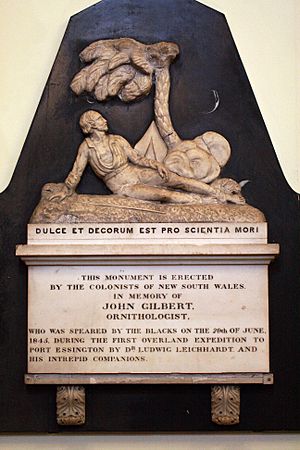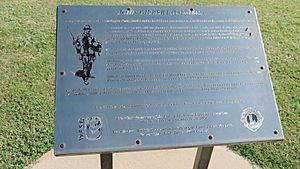John Gilbert (naturalist) facts for kids
John Gilbert (born 1812 – died 1845) was an English naturalist and explorer. He is famous for helping to describe many Australian animals. Many of these animals were new to European scientists. Some animals were even named after him. Gilbert traveled to the new Swan River Colony in Australia. There, he collected information and specimens of unique birds and mammals. He later joined long trips to distant parts of the country. He continued to record and collect specimens until he died during a fight at the Mitchell River (Queensland) on the Cape York Peninsula.
Contents
Who Was John Gilbert?
John Gilbert was born in London, England, on March 14, 1812. His parents were William and Ann Gilbert.
He worked as a taxidermist for the Zoological Society of London. A taxidermist prepares, stuffs, and mounts animal skins to make them look alive. This is where he met a famous naturalist named John Gould. Gould hired Gilbert to work with him. However, Gilbert was later fired for being absent from work without permission.
Exploring Australia
In 1838, Gilbert traveled to Australia with John Gould and Gould's young nephew. Gilbert was paid a yearly salary plus his travel costs. He had to keep careful records of all his spending.
Gilbert and Gould arrived in Hobart, Tasmania, in September 1838. They both worked in Tasmania for a few months.
First Trip to Western Australia
In January 1839, Gould decided they should work separately. He sent Gilbert to the Swan River Colony in Western Australia. Gould promised to look after Gilbert's belongings in Hobart. Gilbert was told to collect as many animal specimens as possible. They planned to meet again in Sydney the next year.
Gilbert arrived in Fremantle on March 6, 1839. Fremantle was the main port for the colony. He soon met Francis Armstrong, who knew the Nyungar Aboriginal peoples of the area. Gilbert began collecting specimens around the Swan River and York. His work helped Gould describe and draw many new birds from Western Australia.
Gould's Work and Gilbert's Collections
While Gilbert was in Western Australia, Gould returned to Hobart. His wife, Elizabeth, was waiting for him there. Gould then traveled to New South Wales and South Australia. He collected many birds and mammals, some of which were new to science. The Goulds left Australia for England in April.
When Gilbert arrived in Sydney on April 30, he found that Gould had already left. To make matters worse, his trunk had been broken into. Many of his personal items that Gould had promised to protect were stolen.
Gilbert had collected thousands of specimens for Gould. These included mammals, insects, shells, crabs, plants, and reptiles. But most importantly, he collected many birds and eggs. He found over 60 new bird species for Gould. This included the now extinct paradise parrot, which he first found in the Darling Downs in June 1844.
The Gouldian Finch
Gilbert later traveled by boat to Port Essington, which was north of where Darwin is today. There, he collected a beautiful, newly discovered finch. He took it back to Gould in England.
Gould was sad because his wife, Elizabeth, had recently died. She was only 37 years old. Gould named the new finch after his wife. Today, this colorful bird is known as the Gouldian finch. Elizabeth had drawn many of the pictures for Gould's books. After her death, Gould had to hire other artists to finish the work.
Gilbert's Namesakes
Gilbert soon returned to Australia to collect more specimens for Gould. He found the paradise parrot again. He thought it was "without exception the most beautiful" bird he had ever seen in Australia. He asked Gould to name it after him. However, Gould refused, saying he didn't like naming species after people. He also said he had recently named another species after Gilbert.
Gould did name the Gilbert's whistler after him. This was a small mistake by Gould. He had already named the eastern version of the same bird. By scientific rules, the first name given is the official one. So, the scientific name today is Pachycephalia inornata. But the name Gilbert's whistler is still commonly used for the bird.
Gould also honored Gilbert by naming two other animals after him. These were the Gilbert's dunnart and Gilbert's potoroo. Gilbert had collected these animals from the thick bushes in southwestern Western Australia.
By the end of January 1844, Gilbert had collected 432 bird specimens, including 36 new species from Western Australia. He also collected 318 mammal specimens, including 22 new species from the west. He was back in Sydney and then traveled to the Darling Downs in Queensland. The Coxen family, who lived in the Darling Downs, were related to Gould's wife. They allowed Gould and Gilbert to stay on their land to collect animals and plants.
Leichhardt's Expedition
While Gilbert was planning his next trip, Ludwig Leichhardt arrived in Sydney. Leichhardt was leading an expedition to Port Essington. Gilbert was allowed to join the group in September 1844.
The group later decided they had too many people for the amount of food they had. Leichhardt wanted the two newest members to leave. In the end, two other men left, and Gilbert stayed. He became almost the second-in-command of the expedition. Gilbert was the best bushman in the group. He took on a lot of responsibility. The expedition moved slower than expected. By May 1845, food supplies were very low.
Gilbert's Death

On June 28, 1845, John Gilbert was killed during a conflict with Aboriginal people. He was hit by a spear. Some people still wonder if he might have died from an accidental shooting by someone in his own group.
Gilbert was buried right where he died. A nearby tree was marked, and a fire was lit over his grave to hide it. Even though people have searched a lot, his grave has never been found since.
After Gilbert's Death
Other members of the expedition were also injured but recovered. Leichhardt then turned south and eventually reached Port Essington in December 1845. He was very tired.
Leichhardt kept Gilbert's papers and his diary. However, the diary was lost for almost 100 years. It was later found by A. H. Chisholm. Most of what we know about Gilbert comes from Chisholm's research. It shows Gilbert as a very capable person with a good character. He also had great respect for the Aboriginal peoples.
Gilbert's Legacy
There is a memorial to John Gilbert in St James' Church, Sydney. It has a Latin phrase that means "it is sweet and fitting to die for science."
There is also a memorial to Gilbert at Gilbert's Lookout in Taroom.
Several places in Australia are named after him, including:
- Gilbert River, which flows into the Gulf of Carpentaria
- Gilberton, a town on the Gilbert River
- Gilbert River Telegraph Station, a historic site
- Gilbert Range, a mountain range
- Gilbert's Dome, a mountain peak
Two animals were also named after him:
- Gilbert's potoroo (Potorous gilbertii), a small mammal
- Gilbert's dragon (Lophognathus gilberti), a type of lizard
On June 28, 1945, people honored Gilbert on the 100th anniversary of his death. Wreaths of Australian wildflowers were placed on his memorial in St James' Church in Sydney. Representatives from several groups, like the Royal Australian Historical Society, were there.
In the 1980s, the Australian Army searched for Gilbert's grave. They have marked what they believe is the likely spot.





